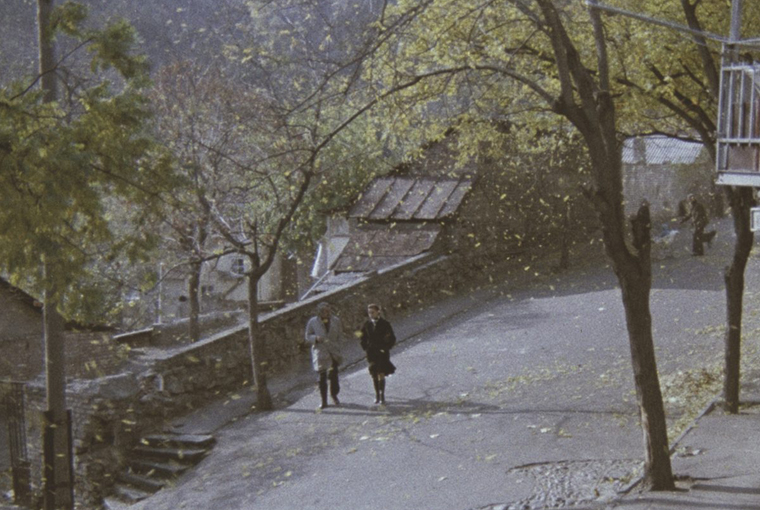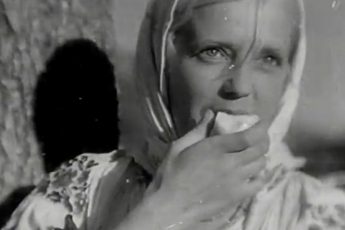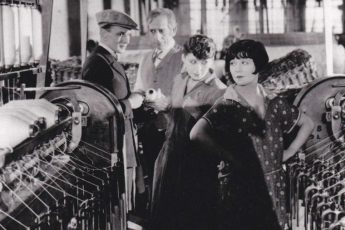Who is Going to Carry the Donkey?
Lana Gogoberidze’s Some Interviews on Personal Matters (Ramdenime interviu pirad sakitkhebze, 1978)
Vol. 100 (December 2019) by Antonis Lagarias
Set in Georgia in the 70s, Some Interviews on Personal Matters follows Sofiko, a woman journalist who interviews women on ‘personal matters’. Through her questions, ‘What do you dream of?’ or ‘What do you do in your free time?’, the film reveals the complex place of women within a traditional and patriarchal society. But in the film, Sofiko is never just a journalist. She always has to assume double roles: she is a mother and a journalist or a wife and a journalist. These are not separate, interchangeable roles, but ones she fulfills simultaneously. Inevitably, her double functions constantly mix and work against one another. They are not part of what she does, but part of who she is. This double identity assumes the place of an existential questioning of family as it reveals the strong solidarity between women who experience the same kind of existential conflict, a conflict which men seem to fail to understand. As the director says: “Men don’t like it when women love their work as much as their family”.
Reproducing common stereotypical phrases like ‘do it for the children’ or ‘do it for your husband’, the film shows how men are unable (or unwilling?) to grasp that Sofiko should do something for herself. In their eyes, her family role is by default the most ‘sacred’ one. Still, the film does not depict these men as macho individuals who wish to oppress women, but more like little people, part of a system they have never begun to question. And questioning is precisely what Sofiko does. She gives voice to women and those who are not heard. As a journalist, she asks the questions that no one wants to hear, personal questions on women issues that can only be understood by women. The film becomes emotional not by accusing men but through affection between women or generally between outsiders. What we are presented with in Lana Gogoberidze’s film is a collaboration between those who share a minoritarian perspective of reality.
Not unlike Akerman’s Jeanne Dielman, 23, Quai du Commerce, 1080 Bruxelles, Lana Gogoberidze’s film is structured around domestic work. In the film, domestic activities are of equal importance as what happens on the outside. While slicing carrots, Sofiko fights with her cheating husband; while Sofiko prepares a meal for her husband, she has to take care of her children. This juxtaposition of functions eventually leads to an impossibility. In the middle of the film, the photographer who accompanies her, shares the story of the kind man’s donkey. His owner puts everyone who is tired on the donkey, until the donkey itself asks the man: “Can I also be carried by the donkey”? The question implies a certain impossibility of Sofiko’s double life, while the question is addressed to the audience: when the donkey is carrying everyone and everything, who is going to carry the donkey?
While the story is both coherent and compelling enough to keep the viewer attached to the screen, the film also beautifully explores some elements of the filmic language. First, we are presented with an interesting use of flashbacks. While flashbacks commonly reveal fragments of past events which come to haunt the character in the present, Sofiko’s flashbacks are of a different nature. They seem to be events, parts of her interviews or her personal life, which co-exist permanently within her and are hidden in a second degree of reality. In that sense she is a carrier of those people who shared their stories with her. In a way, she is the incarnation of these questions around loneliness, women and family. During the flashback scenes, she does not look away as if delving in her memories. Her eyes are fixated on the camera like she is the one projecting this memory onto the screen. The flashbacks are not an inward but an outward journey: Sofiko recalls these fragments in a lucid, voluntary way.
Second, in perhaps the most beautiful sequence of the film, we have a scene of pure Italian neo-realism where the action is suspended and we are uncertain of what we see. After learning that her husband is cheating on her, Sofiko goes to the photographer’s atelier, where he is painting. Covered in paint, he prepares tea for her while she seems to fall asleep. As he looks at her face, the light and the texture on their skin change, they seem to be transposed into a no-place outside of time, and are transformed into a still painting while all action is suspended. As though floating in a strange room, he observes her while sleeping. This state of suspension stops when she wakes up. Reality returns and all we are left with is the equivalent of a shared moment, a union of spirits, an alternative erotic scene outside of time.
Lana Gogoberidze is part of a women filmmaker generation who put women issues on screen from a female perspective. Not unlike the French feminist film movement, her film proclaims that there are things that exceed men’s understanding on women matters, and thus women should take control of cinematic means and openly speak about what concerns them. This is precisely what Sofiko does in the film, perhaps as a prolongation of the director herself, but still she is less of a militant feminist and more of a woman with her double existence (family-work). Her activism suggests that under certain circumstances, being conscious of and challenging the impossibility that is demanded from a woman to simultaneously be a mother/wife and still work independently, is a fundamental form of being politically active in a community.



Leave a Comment